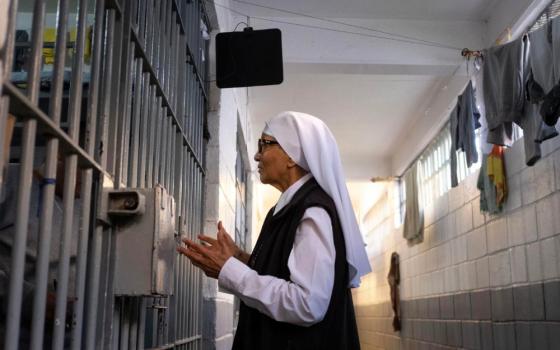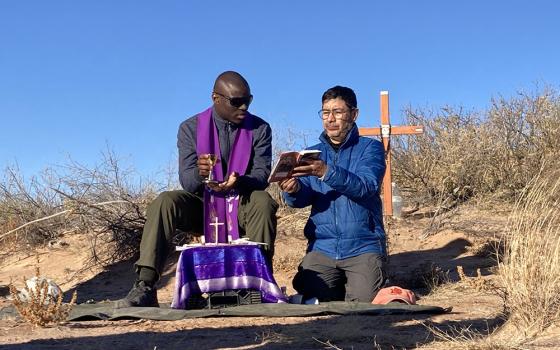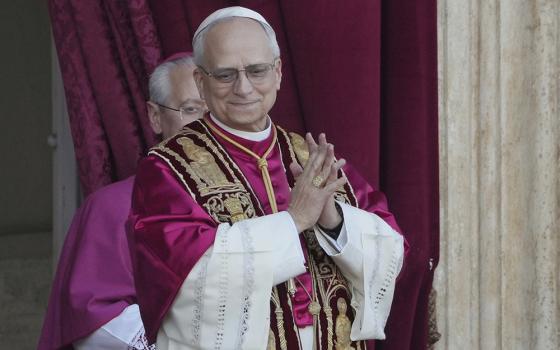
(Unsplash/Ben Berwers)
Editor's note: This story is part of Global Sisters Report's yearlong series, "Out of the Shadows: Confronting Violence Against Women," which will focus on the ways Catholic sisters are responding to this global phenomenon.

(GSR logo/Olivia Bardo)
A disturbing video recently circulated showing an older Catholic sister repeatedly slapping a younger member of her congregation in Kenya. The footage captures not just physical violence, but something more troubling: the abuse of power within hierarchical religious structures that demands systematic examination.
The Franciscan Sisters of St. Joseph immediately acknowledged the incident as "deeply regrettable," and the Association of Sisterhoods of Kenya declared that "safeguarding is no longer optional within religious life. It is a Gospel imperative and a moral responsibility." These responses, while commendable, highlight a critical question: Why do such incidents continue to occur despite religious communities' stated commitments to the safety and dignity of their members?
The Kenyan assault cannot be dismissed as an isolated incident. This summer, international researchers gathered at the University of Regensburg for a groundbreaking conference titled "Behind the Veil: Analyzing the Hidden Patterns of Spiritual and Sexual Abuse among Catholic Women Religious." Studies presented from Europe, Africa, Latin America, Asia and North America revealed strikingly similar patterns of abuse within religious communities across vastly different cultural contexts.
The research exposes how religious authority structures create what scholars term
"vulnerance" — a concept introduced by German theologian Hildegund Keul and expanded on by German professor Ute Leimgruber to describe the structural readiness to use violence in connection with vulnerabilities. Unlike individual vulnerability, vulnerance describes how institutional factors within religious communities — hierarchical power structures, cultures of secrecy, and the weaponization of concepts like the vow of obedience and "God's will" — create systematic conditions where abuse becomes not just possible, but structurally enabled.
The church continues to consistently frame these incidents as aberrations rather than predictable outcomes of concentrated power operating without adequate oversight.
An international research consortium is now preparing the first comprehensive global survey of Catholic women religious, spanning three years, to investigate the safety and quality of religious life for sisters worldwide. The very need for such extensive research reveals a troubling gap: Basic data about the well-being of women religious simply doesn't exist, leaving institutions without accountability mechanisms that secular organizations routinely maintain.
The video from Kenya illustrates how abuse stems from institutional power imbalances rather than individual character flaws. The older sister's actions weren't aberrant behavior but rather the predictable outcome of unchecked authority within hierarchical structures. Her words — "You know this child is very stupid" — reveal how age and seniority within religious communities can create dynamics that dehumanize, humiliate and infantilize younger members.
Religious institutions often attempt to frame such incidents as personal failings while avoiding examination of the structural conditions that enable them. This approach fails to address the systematic factors that enable abuse: how spiritual authority creates unique forms of psychological control, how communal living arrangements and the closed-off nature of religious orders can isolate individuals from external support, and how religious concepts become tools of manipulation.
Understanding why such incidents persist requires examining the structural conditions that enable them. Religious communities often function as what sociologist Erving Goffman termed "total institutions" — environments with complete control over members' daily lives, isolation from the outside world, rigid power hierarchies and systematic identity reformation through formation programs.
Advertisement
The three religious vows — poverty, chastity and obedience — intended as spiritual disciplines, can create interlocking dependencies that make resistance difficult. Poverty eliminates economic independence, leaving members financially dependent on the very institution that might harm them. Chastity creates social isolation by limiting meaningful relationships both within and outside the community. Obedience systematically undermines individual moral reasoning, framing personal judgment as spiritual immaturity while presenting superiors' commands as divine will.
The Association of Sisterhoods of Kenya's response to the assault demonstrates both the possibilities and limitations of current approaches. While their immediate condemnation and call for safeguarding protocols represent important steps, reactive responses to individual incidents cannot address the systematic conditions that enable abuse.
Meaningful reform requires proactive measures: comprehensive safeguarding training that addresses power dynamics rather than just individual conduct; external oversight mechanisms that provide accountability independent of internal hierarchies; and systematic data collection that tracks institutional culture and member well-being over time.
Most critically, it requires recognizing that safeguarding isn't about protecting only those deemed especially vulnerable, but about creating institutional cultures that prevent the abuse of power in all its forms.
Religious communities cannot claim moral authority while failing to protect their own members from harm. The documented patterns of abuse across continents reveal that this isn't a problem of individual bad actors but of institutional systems that enable and conceal abuse.
The Kenyan incident offers a moment of reckoning. Religious institutions can continue to respond reactively to individual cases while maintaining the structural conditions that enable abuse, or they can embrace the systematic reforms that their own research shows are desperately needed.
As the Association of Sisterhoods of Kenya correctly observed, safeguarding is indeed a Gospel imperative. Yet there remains a troubling disconnect between this moral clarity and institutional practice — a pattern of responding with individual solutions to structural problems. The church continues to consistently frame these incidents as aberrations rather than predictable outcomes of concentrated power operating without adequate oversight.
Religious institutions and the Catholic Church at large can continue responding reactively to individual cases while maintaining the structural conditions that enable abuse, or they can embrace the systematic reforms that mounting evidence shows are desperately needed. Behind each incident lies real human suffering — women whose faith is weaponized against them, their devotion exploited, their voices silenced by the very systems they trusted with their entire lives. The choice will determine not only whether religious communities can align their practices with the Gospel values they claim to uphold, but whether they can stop actively perpetuating the suffering of those they are called to protect.








